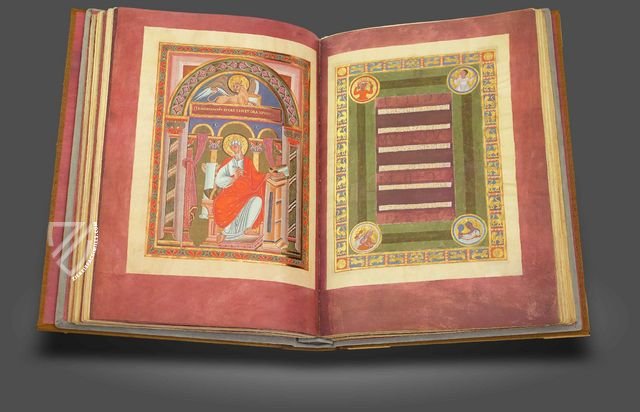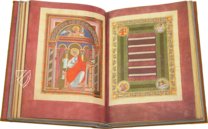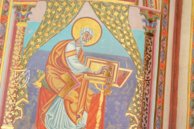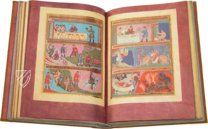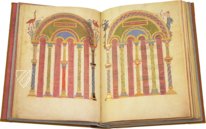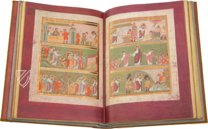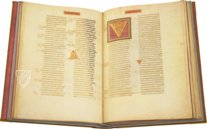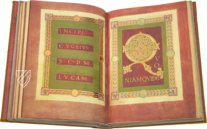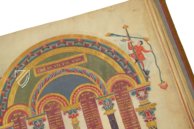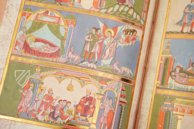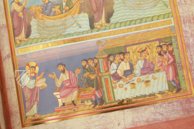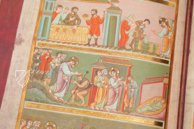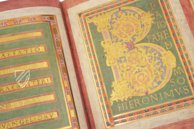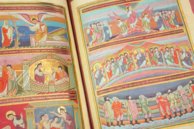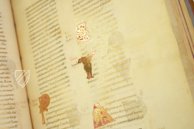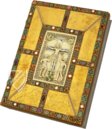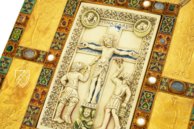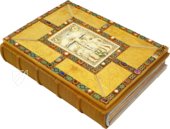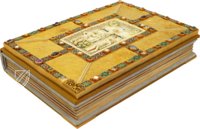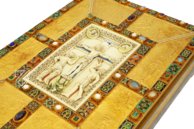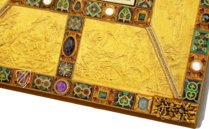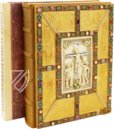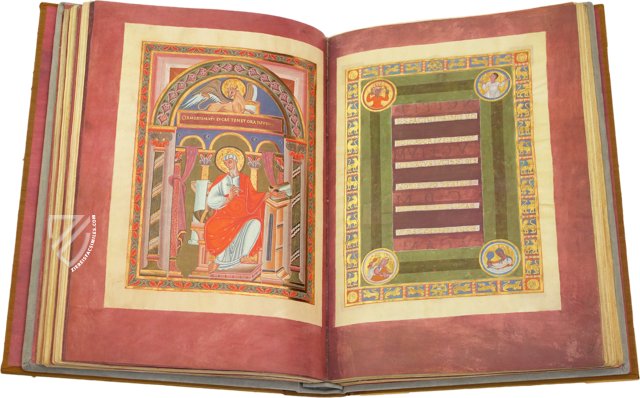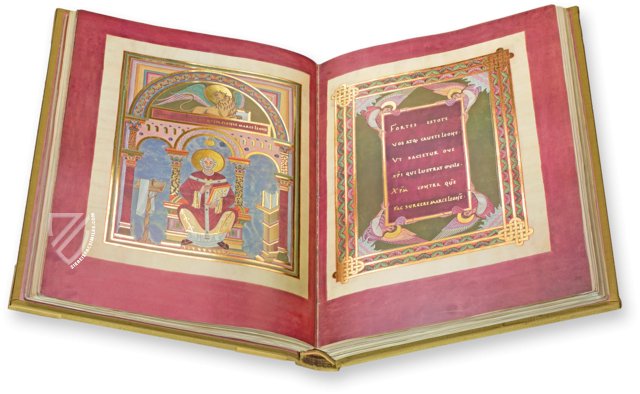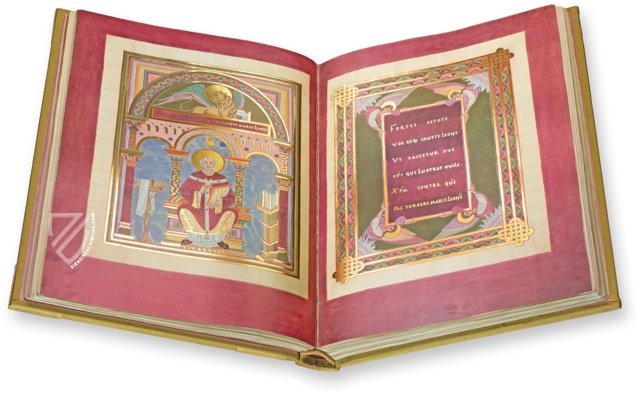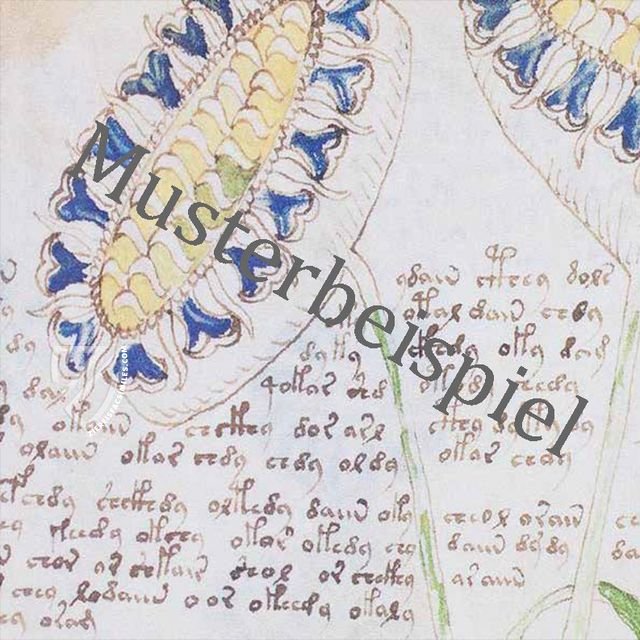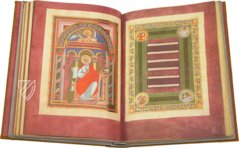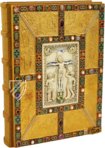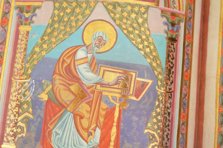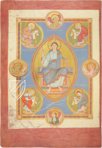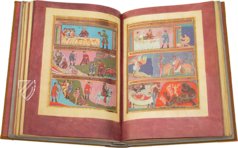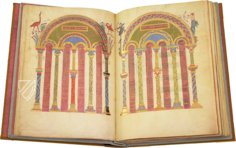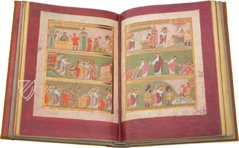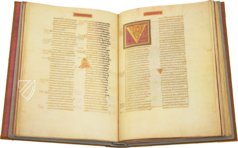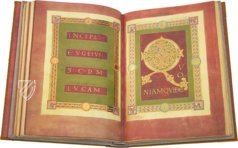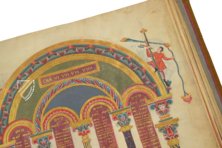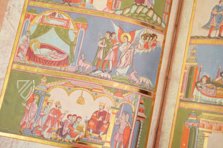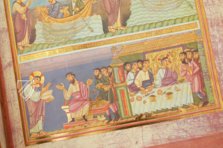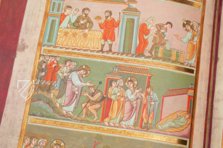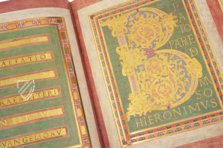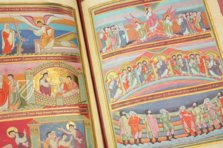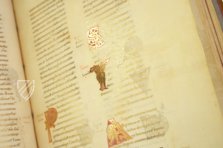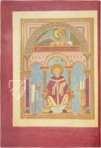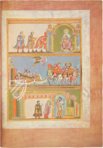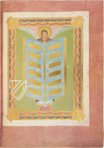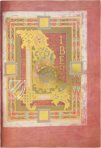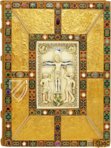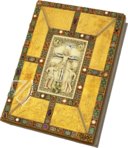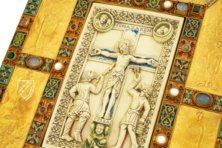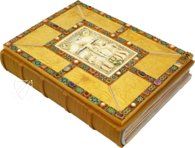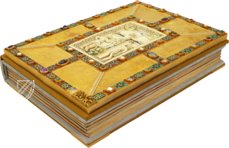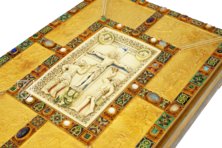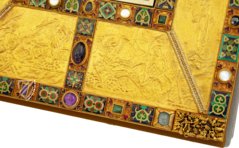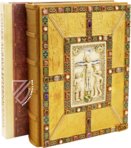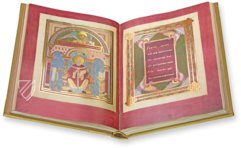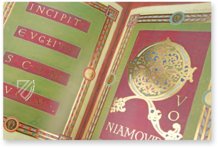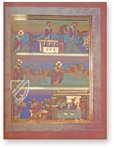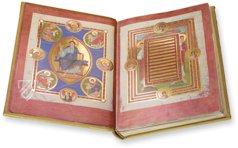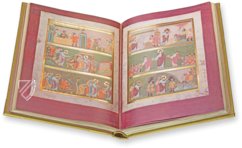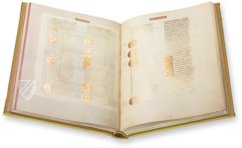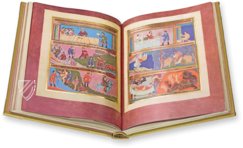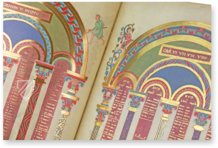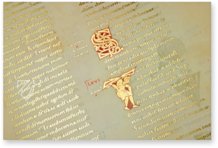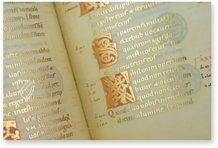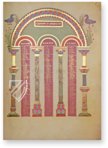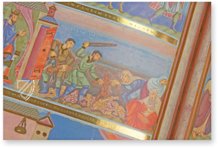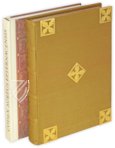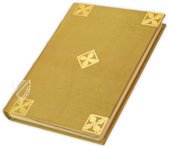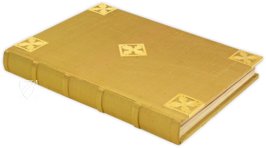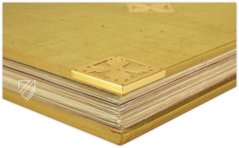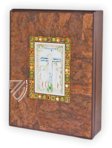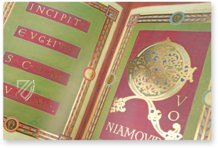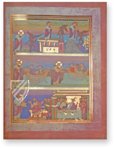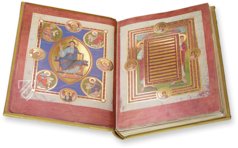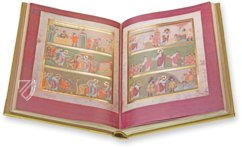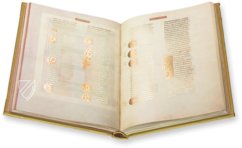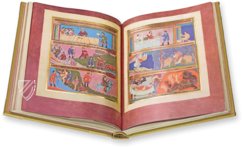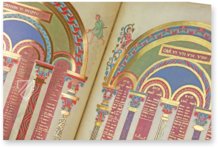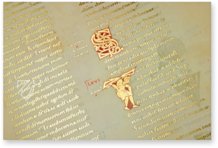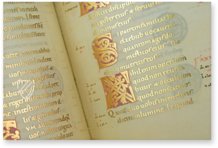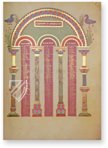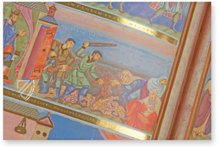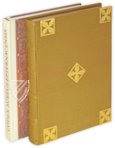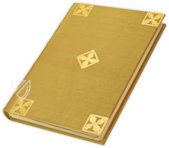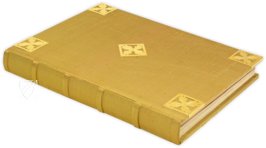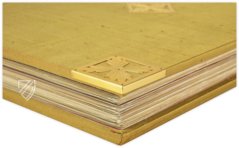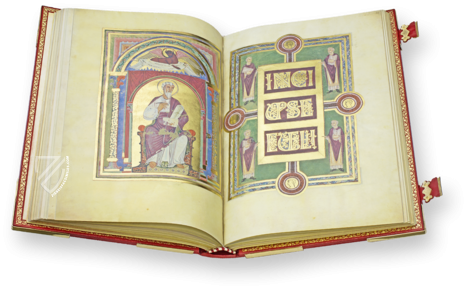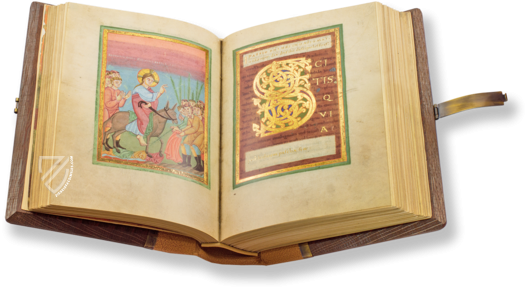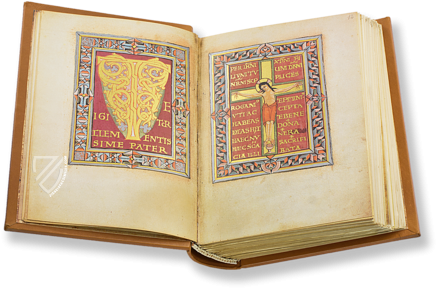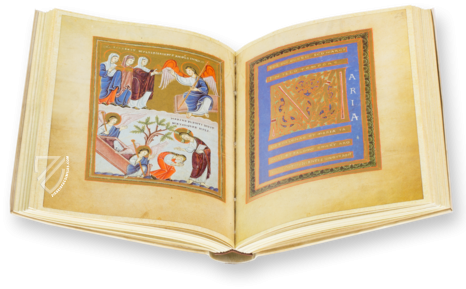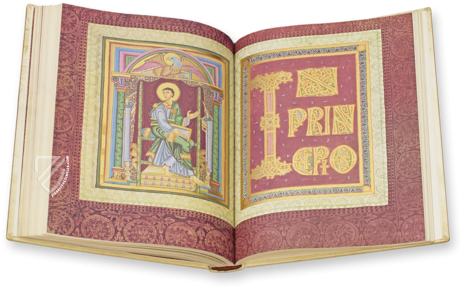Codex Aureus of Echternach
The Codex Aureus Epternacensis or Golden Gospels of Echternach is one of the most beautiful books to have survived to the present day. It originated from the famous scriptorium of the Benedictine Abbey of Echternach in Luxemburg, which produced dozens of masterpieces of Carolingian and Ottonian illumination. The text is completely written in gold ink and furnished with 64 magnificent miniatures, numerous purple pages, as well as five Evangelist portraits, decorative canon tables, and other decorative elements. Classical architectures with arches and columns, borders with geometric and acanthus leaf patterns, and interlace initials additionally adorn the text. The De Luxe Edition features a cover with replica ivory plate showing the crucifixion, magnificent gemstones, and enamel work. This manuscript represents one of the most magnificent works of medieval illumination from any epoch.
Golden Gospels of Echternach
This Gospel book is a work of inconceivable magnificence, extravagant in its wealth of visual motifs, handsome ornamentation, and splendidly colored scenes depictions of biblical events. The size of the parchment pages (31 x 44 cm) already betrays the significance of this book as an object of prestige. The Echternach school of painting reveals the full bloom of its unique mastery in 64 full-page miniatures and canon tables and hundreds of precious initials. The dignified impression of the manuscript is elevated by silver tones and imperial purple. The name of the Codex Aureus originates from its extravagant use of gold on nearly every page.
Echternach Monastery and Saint Willibrord
The Benedictine Abbey of Echternach in Luxemburg was founded by Saint Willibrord (ca. 658–739), an Anglo-Saxon itinerant monk from Northumbria. When he died at Echternach at the age of 81, he had long since laid the groundwork for Echternach to host one of the most important imperial scriptoria on the continent, and arguably the most important. In the 11th century, the ruling Salian dynasty named it their court atelier. An estimated 100 magnificent and golden illustrated manuscripts were made in Echternach during this century: the Echternach Sacramentary, Echternach Evangeliary, Pericopes of Henry III, the Salian Imperial Evangeliary…none, however, is as beautiful and as famous as the Golden Gospel Book - the Codex Aureus Epternacensis.
Gorgeous Text
The parchment pages, on which the text of the Gospels is written down in pure gold, the symbol of light and enlightenment, are particularly gorgeous. The text itself appears in two columns; it is animated with small golden initials or larger initials, which are interspersed with wickerwork. Human figures, birds, and columns often serve as ornaments. To emphasize individual passages, initials were painted that extend over an entire column.
A Glimpse of Everyday Life
The great picture cycle of the New Testament appears in four parts, which appear at the beginning of the respective Gospel texts. In them, the biblical events are depicted with a wealth of lively details. On sixteen pages, more than a hundred individual representations are subdivided into three zones. Each of the four parts covers a period of Christ’s life on earth. The fidelity to the biblical text has been preserved down to the smallest detail. All the pictures are a mirror of the Middle Ages. Thus the Codex Aureus represents an inexhaustible source for the study of everyday medieval life.
Codicology
- Alternative Titles
- Codex Aureus Epternacensis
Goldenes Evangelienbuch von Echternach
Golden Gospels of Echternach - Size / Format
- 272 pages / 44.5 × 31.0 cm
- Origin
- Luxembourg
- Date
- 1020–1050
- Style
- Genre
- Language
- Script
- Carolingian minuscule Uncial
- Illustrations
- 64 illuminated pages, 16 full-page miniatures (each with 3 scenes), 5 evangelist portraits, 10 canon tables, 9 full-page, 16 half-page and 503 smaller initials, entire text written with gold ink
- Content
- Canon tables, four Gospels
- Patron
- Probably Abbot Humbert von Echternach (1018–1051), cover commissioned by Emperor Otto III (980–1002) and his mother Theophanu (960–991)
- Artist / School
- Master of the Registrum Gregorii (influence)
- Previous Owners
- Duke Ernst II of Saxe-Coburg and Altenburg (1745-1804)
House of Coburg-Gotha
Codex Aureus of Echternach
Entablature of a Canon Table
The Gospels of Matthew and Luke are presented side by side under four arches to aid the reader in their religious studies – these are the Canon Tables created by Eusebius of Caesarea. Resting on five columns with artful capitals, this elaborate entablature is exemplary of Ottonian illumination and the scriptorium of Echternach Monastery in particular. It makes use of only the finest pigments and glimmering gold leaf, all executed by some of the finest illuminators of the period.
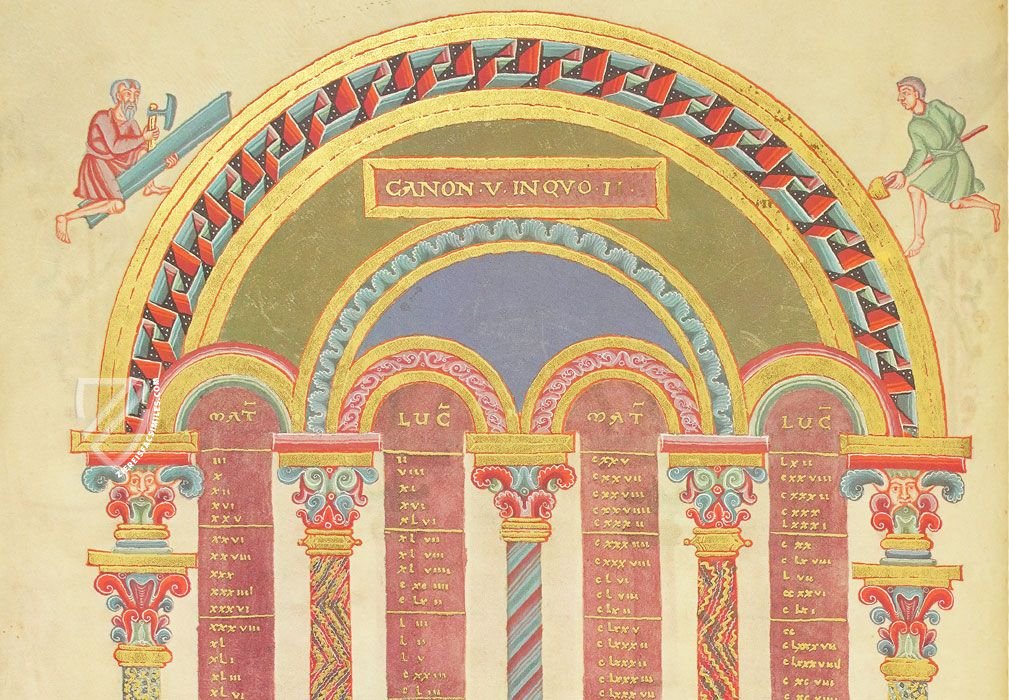
Codex Aureus of Echternach
Adoration of the Magi/ Dream of Magi and departure by horseback/Presentation of Jesus in the Temple
This impressive manuscript contains more than one hundred colorful individual scenic depictions of passages from the New Testament. Different periods of Christ's life are illuminated in three zones, one below the other. The particularly generous use of gold to frame the individual scenes and to accentuate pictorial motifs testifies to the special richness of the codex. Added to this is the value of the content of the illustrations, in that the faithfulness to the biblical text is preserved down to the smallest detail.
In the upper section of the picture, the Magi are depicted presenting their gifts. Mary and the infant Jesus are embedded in a magnificent columned architecture, artfully masking the humble birthplace of Christ. In the masterful and detailed representation, above the architecture is the red shining star of Bethlehem, which showed the way to the three saints.
While the middle section of the picture continues the Gospel of Matthew with the dream of the Magi, the lower scene shows the offering of Jesus in the temple according to Luke (2, 22-35). Here, also, it is demonstrated with particular richness of detail how Jesus is handed over to Simeon at the altar of the temple. Mary and Joseph stand in the elaborately decorated temple room, while Mary holds two doves ready for the sacrifice.
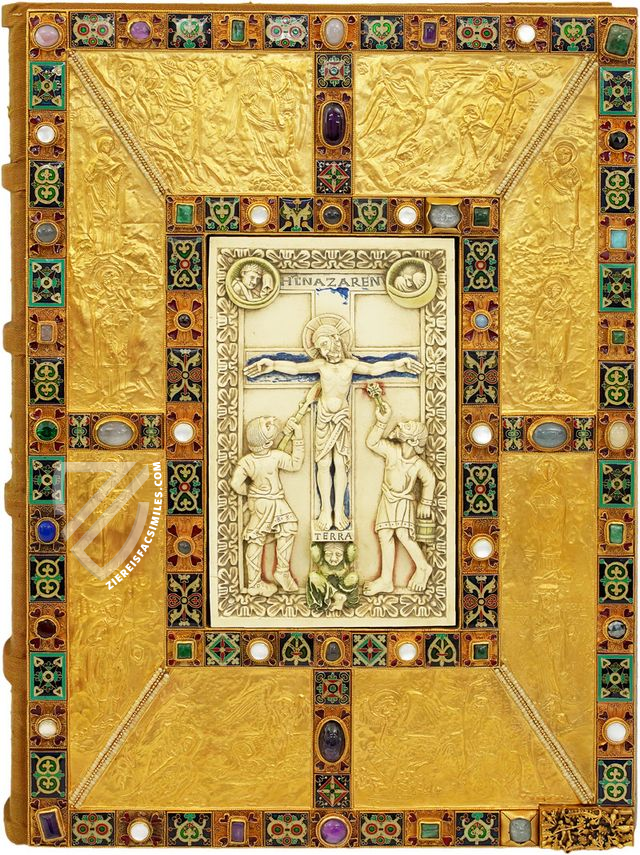
#1 Goldenes Evangelienbuch von Echternach (Luxury Edition)
Language: German
#2 Goldenes Evangelienbuch von Echternach (Standard Edition)
Language: German
(3,000€ - 7,000€)
#3 Goldenes Evangelienbuch von Echternach (Cork Box Edition)
Language: German
(3,000€ - 7,000€)
#4 Das Goldene Evangelienbuch von Echternach (Collection)
Language: German
- Treatises / Secular Books
- Apocalypses / Beatus
- Astronomy / Astrology
- Bestiaries
- Bibles / Gospels
- Chronicles / History / Law
- Geography / Maps
- Saints' Lives
- Islam / Oriental
- Judaism / Hebrew
- Single Leaf Collections
- Leonardo da Vinci
- Literature / Poetry
- Liturgical Manuscripts
- Medicine / Botany / Alchemy
- Music
- Mythology / Prophecies
- Psalters
- Other Religious Books
- Games / Hunting
- Private Devotion Books
- Other Genres
- Afghanistan
- Armenia
- Austria
- Belgium
- Belize
- Bosnia and Herzegovina
- China
- Colombia
- Costa Rica
- Croatia
- Cyprus
- Czech Republic
- Denmark
- Egypt
- El Salvador
- Ethiopia
- France
- Germany
- Greece
- Guatemala
- Honduras
- Hungary
- India
- Iran
- Iraq
- Israel
- Italy
- Japan
- Jordan
- Kazakhstan
- Kyrgyzstan
- Lebanon
- Liechtenstein
- Luxembourg
- Mexico
- Morocco
- Netherlands
- Palestine
- Panama
- Peru
- Poland
- Portugal
- Romania
- Russia
- Serbia
- Spain
- Sri Lanka
- Sweden
- Switzerland
- Syria
- Tajikistan
- Turkey
- Turkmenistan
- Ukraine
- United Kingdom
- United States
- Uzbekistan
- Vatican City
- A. Oosthoek, van Holkema & Warendorf
- Aboca Museum
- Ajuntament de Valencia
- Akademie Verlag
- Akademische Druck- u. Verlagsanstalt (ADEVA)
- Aldo Ausilio Editore - Bottega d’Erasmo
- Alecto Historical Editions
- Alkuin Verlag
- Almqvist & Wiksell
- Amilcare Pizzi
- Andreas & Andreas Verlagsbuchhandlung
- Archa 90
- Archiv Verlag
- Archivi Edizioni
- Arnold Verlag
- ARS
- Ars Magna
- ArtCodex
- AyN Ediciones
- Azimuth Editions
- Badenia Verlag
- Bärenreiter-Verlag
- Belser Verlag
- Belser Verlag / WK Wertkontor
- Benziger Verlag
- Bernardinum Wydawnictwo
- BiblioGemma
- Biblioteca Apostolica Vaticana (Vaticanstadt, Vaticanstadt)
- Bibliotheca Palatina Faksimile Verlag
- Bibliotheca Rara
- Boydell & Brewer
- Bramante Edizioni
- Bredius Genootschap
- Brepols Publishers
- British Library
- C. Weckesser
- Caixa Catalunya
- Canesi
- CAPSA, Ars Scriptoria
- Caratzas Brothers, Publishers
- Carus Verlag
- Casamassima Libri
- Centrum Cartographie Verlag GmbH
- Chavane Verlag
- Christian Brandstätter Verlag
- Circulo Cientifico
- Club Bibliófilo Versol
- Club du Livre
- CM Editores
- Collegium Graphicum
- Collezione Apocrifa Da Vinci
- Comissão Nacional para as Comemorações dos Descobrimentos Portugueses
- Coron Verlag
- Corvina
- CTHS
- D. S. Brewer
- Damon
- De Agostini/UTET
- De Nederlandsche Boekhandel
- De Schutter
- Deuschle & Stemmle
- Deutscher Verlag für Kunstwissenschaft
- DIAMM
- Droz
- E. Schreiber Graphische Kunstanstalten
- Ediciones Boreal
- Ediciones Grial
- Ediclube
- Edições Inapa
- Edilan
- Editalia
- Edition Deuschle
- Edition Georg Popp
- Edition Leipzig
- Edition Libri Illustri
- Editiones Reales Sitios S. L.
- Éditions de l'Oiseau Lyre
- Editions Medicina Rara
- Editorial Casariego
- Editorial Mintzoa
- Editrice Antenore
- Editrice Velar
- Edizioni Edison
- Egeria, S.L.
- Eikon Editores
- Electa
- Emery Walker Limited
- Enciclopèdia Catalana
- Eos-Verlag
- Ephesus Publishing
- Ernst Battenberg
- Eugrammia Press
- Extraordinary Editions
- Fackelverlag
- Facsimila Art & Edition
- Facsimile Editions Ltd.
- Facsimilia Art & Edition Ebert KG
- Faksimile Verlag
- Feuermann Verlag
- Folger Shakespeare Library
- Franco Cosimo Panini Editore
- Friedrich Wittig Verlag
- Fundación Hullera Vasco-Leonesa
- G. Braziller
- Gabriele Mazzotta Editore
- Gebr. Mann Verlag
- Gesellschaft für graphische Industrie
- Getty Research Institute
- Giovanni Domenico de Rossi
- Giunti Editore
- Graffiti
- Grafica European Center of Fine Arts
- Guido Pressler
- Guillermo Blazquez
- Gustav Kiepenheuer
- H. N. Abrams
- Harrassowitz
- Harvard University Press
- Helikon
- Hendrickson Publishers
- Henning Oppermann
- Herder Verlag
- Hes & De Graaf Publishers
- Hoepli
- Holbein-Verlag
- Houghton Library
- Hugo Schmidt Verlag
- Idion Verlag
- Il Bulino, edizioni d'arte
- ILte
- Imago
- Insel Verlag
- Insel-Verlag Anton Kippenberger
- Instituto de Estudios Altoaragoneses
- Instituto Nacional de Antropología e Historia
- Introligatornia Budnik Jerzy
- Istituto dell'Enciclopedia Italiana - Treccani
- Istituto Ellenico di Studi Bizantini e Postbizantini
- Istituto Geografico De Agostini
- Istituto Poligrafico e Zecca dello Stato
- Italarte Art Establishments
- Jan Thorbecke Verlag
- Johnson Reprint Corporation
- Josef Stocker
- Josef Stocker-Schmid
- Jugoslavija
- Karl W. Hiersemann
- Kasper Straube
- Kaydeda Ediciones
- Kindler Verlag / Coron Verlag
- Kodansha International Ltd.
- Konrad Kölbl Verlag
- Kurt Wolff Verlag
- La Liberia dello Stato
- La Linea Editrice
- La Meta Editore
- Lambert Schneider
- Landeskreditbank Baden-Württemberg
- Leo S. Olschki
- Les Incunables
- Liber Artis
- Library of Congress
- Libreria Musicale Italiana
- Lichtdruck
- Lito Immagine Editore
- Lumen Artis
- Lund Humphries
- M. Moleiro Editor
- Maison des Sciences de l'homme et de la société de Poitiers
- Manuscriptum
- Martinus Nijhoff
- Maruzen-Yushodo Co. Ltd.
- MASA
- Massada Publishers
- McGraw-Hill
- Metropolitan Museum of Art
- Militos
- Millennium Liber
- Müller & Schindler
- Nahar - Stavit
- Nahar and Steimatzky
- National Library of Wales
- Neri Pozza
- Nova Charta
- Oceanum Verlag
- Odeon
- Orbis Mediaevalis
- Orbis Pictus
- Österreichische Staatsdruckerei
- Oxford University Press
- Pageant Books
- Parzellers Buchverlag
- Patrimonio Ediciones
- Pattloch Verlag
- PIAF
- Pieper Verlag
- Plon-Nourrit et cie
- Poligrafiche Bolis
- Presses Universitaires de Strasbourg
- Prestel Verlag
- Princeton University Press
- Prisma Verlag
- Priuli & Verlucca, editori
- Pro Sport Verlag
- Propyläen Verlag
- Pytheas Books
- Quaternio Verlag Luzern
- Reales Sitios
- Recht-Verlag
- Reichert Verlag
- Reichsdruckerei
- Reprint Verlag
- Riehn & Reusch
- Roberto Vattori Editore
- Rosenkilde and Bagger
- Roxburghe Club
- Salerno Editrice
- Saltellus Press
- Sandoz
- Sarajevo Svjetlost
- Schöck ArtPrint Kft.
- Schulsinger Brothers
- Scolar Press
- Scrinium
- Scripta Maneant
- Scriptorium
- Shazar
- Siloé, arte y bibliofilia
- SISMEL - Edizioni del Galluzzo
- Sociedad Mexicana de Antropología
- Société des Bibliophiles & Iconophiles de Belgique
- Soncin Publishing
- Sorli Ediciones
- Stainer and Bell
- Studer
- Styria Verlag
- Sumptibus Pragopress
- Szegedi Tudomànyegyetem
- Taberna Libraria
- Tarshish Books
- Taschen
- Tempus Libri
- Testimonio Compañía Editorial
- Thames and Hudson
- The Clear Vue Publishing Partnership Limited
- The Facsimile Codex
- The Folio Society
- The Marquess of Normanby
- The Richard III and Yorkist History Trust
- Tip.Le.Co
- TouchArt
- TREC Publishing House
- TRI Publishing Co.
- Trident Editore
- Tuliba Collection
- Typis Regiae Officinae Polygraphicae
- Union Verlag Berlin
- Universidad de Granada
- University of California Press
- University of Chicago Press
- Urs Graf
- Vallecchi
- Van Wijnen
- VCH, Acta Humaniora
- VDI Verlag
- VEB Deutscher Verlag für Musik
- Verlag Anton Pustet / Andreas Verlag
- Verlag Bibliophile Drucke Josef Stocker
- Verlag der Münchner Drucke
- Verlag für Regionalgeschichte
- Verlag Styria
- Vicent Garcia Editores
- W. Turnowski Ltd.
- W. Turnowsky
- Waanders Printers
- Wiener Mechitharisten-Congregation (Wien, Österreich)
- Wissenschaftliche Buchgesellschaft
- Wissenschaftliche Verlagsgesellschaft
- Wydawnictwo Dolnoslaskie
- Xuntanza Editorial
- Zakład Narodowy
- Zollikofer AG

